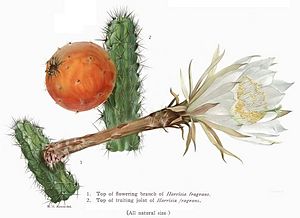Fragrant prickly apple facts for kids
Quick facts for kids Fragrant prickly apple |
|
|---|---|
 |
|
| Conservation status | |
| Scientific classification | |
| Genus: |
Harrisia (plant)
|
| Species: |
fragrans
|
Harrisia fragrans is a very rare type of cactus. It is also known as the fragrant prickly apple or Caribbean applecactus. This plant is found only in Florida, mainly in St. Lucie County. Its natural home has almost completely disappeared because of new buildings and towns. Because of this, it is an endangered species in the United States.
What Does It Look Like?
This cactus grows tall and wide, with long, thin stems that can reach over 1 meter (about 3 feet) and sometimes even up to 5 meters (about 16 feet) long! It has long, sharp spines, up to 4 centimeters (about 1.5 inches) long, that are yellow or have yellow tips.
At night, it blooms with huge, sweet-smelling flowers. These flowers can be up to 20 centimeters (about 8 inches) long and are white or light pink. Its fruit is round, red or orange, and about 6 centimeters (about 2.5 inches) wide. Birds love to eat these fruits, which helps spread the cactus seeds.
This cactus can live for at least 19 years. Younger plants don't make many seeds, but older, bigger plants produce more. Small cacti sometimes grow better when they are near "nurse plants" that offer them protection.
Where Does It Live?
This cactus loves to grow in coastal "hammocks," which are like small forests with some shade. It needs shade because too much sun can dry it out. Sadly, many of these coastal hammocks have been cleared for buildings, breaking up the cactus's home.
Today, we know of ten places where this plant grows. Nine of these are around Savannas Preserve State Park in St. Lucie County. In 2002, about 2,150 of these cacti were found there. The tenth group is at the Canaveral National Seashore in Volusia County, with about 96 plants. There might be another group in Indian River County, but it hasn't been officially confirmed. This cactus used to grow in Brevard County, but those groups have disappeared.
Why Is It in Danger?
The remaining groups of Harrisia fragrans are now found in sandy scrub areas. These areas are often harmed by plants that don't belong there, like "love vine" (Cassytha filiformis). Even though the cactus needs some shade, it can't grow if it's completely covered by other plants.
Other dangers to the cactus include:
- Off-road vehicles
- Chemicals used to kill plants
- Wild pigs
- Damage from strong winds and falling branches during hurricanes
- People harming the plants with tools
- Cacti getting buried in sand
- People stealing cacti for their collections
Some insects, like a type of scale insect called Diaspis echinocacti, sometimes eat the cactus stems. Certain caterpillars can also cause damage. Woodpeckers have been seen poking holes in the stems, which hurts the plants. Luckily, most of the remaining cactus groups are inside a state park, so their homes are safe from new buildings.
Images for kids
See also




